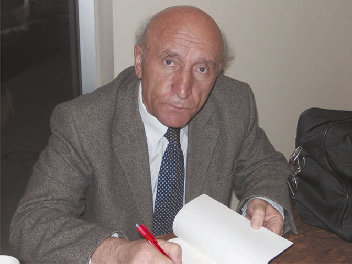Pateel Mekhitarian
Staff Writer

On Wednesday, November 5, Dr. Azat Yeghiazaryan, Director of the Abeghyan Institute of Literature of the Armenian National Academy of Sciences, visited the Fresno State campus to give a lecture on the Armenian traditional folk epic David of Sasun. Dr. Yeghiazaryan’s new book, The Armenian Folk Epic of David of Sasun, translated from Armenian by Dr. S. Peter Cowe, has just been published by Mazda Press. The Fresno lecture was part of a nation-wide tour by Dr. Yeghiazaryan.
David of Sasun is an Armenian national hero who is best known for defending Armenia from various invaders. He was a medieval epic character who is important in understanding the Armenian culture and psychology. He, and the other heroes, embody, according to Dr. Yeghiazaryan, “society’s ideals of freedom and guileless nobility, empathy towards the stranger, and a spiritual affinity with all living things.”
Dr. Yeghiazaryan explained that the epic presents a rich legacy of accumulated folk wisdom, as it tells the tale of the lives, loves, and heroic struggles of four generations of the House of Sasun. In his book, he discusses the epic in the context of the Western European, Slavic, and Caucasian traditions.
Originally, the epic was transmitted only orally from generation to generation, until it was recorded for the first time in 1873 by Garegin Srvandztiants (1840-1892). The epic has an alternative name of “The Daredevils of Sasun,” however it is popularly referred to as David of Sasun, for the hero of the third and major branch of the epic.
There are four cycles in the epic, each named after their hero. The first cycle is about two brothers Sanasar and Baghdasar. Sanasar’s son, Lion Mher, is the hero of the second cycle. The third cycle is about David and the fourth cycle is about David’s son, Little Mher.
The epic begins with David’s great-grandmother, Lady Dzovinar, who agrees to marry the King of Baghdad in order to save the Armenian people. Lady Dzovinar became miraculously pregnant by bathing in a spring, thereby giving birth to Sanasar and Baghdasar, who are both extraordinarily powerful. Once he was old enough, Sanasar founded Sasun, the fortress-town of Armenia.
All of the heroes embody characteristics that are significant in Armenian culture. They represent the strong, fearless men who protect their country. All four Armenian epic figures were great role models for the Armenia people. They faced and defeated evil enemies, such as Msra Melik, the Egyptian king.
Historians think that the epic dates to the eighth century because life for the Armenians then was very similar to the way it was described in the epic. Dr. Yeghiazaryan discussed the fact that there remains much research to be done on the epic . Unfortunately, the Armenian Genocide of 1915 spelled the end of the oral transmission of the epic.
The epic oral traditions are a part of the Armenian culture that defines the people. The existence of these stories established national heroes and role models for the Armenian people, and molded an outlook for future. Although the epic of David of Sasun is no longer orally transmitted, its historical and cultural importance remains.
 Hye Sharzhoom Armenian Action
Hye Sharzhoom Armenian Action